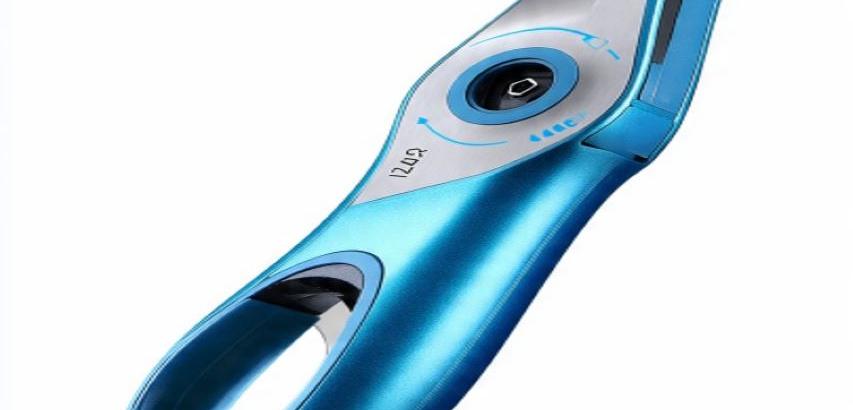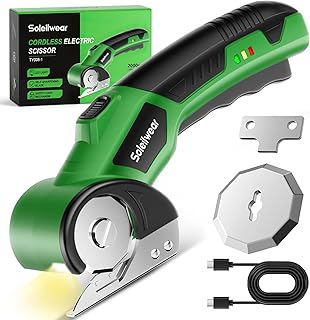
Electric Scissors are power-assisted cutting tools designed to replace the repetitive hand-squeezing motion of traditional manual scissors with an electrically driven, motorized action. They are engineered to reduce user fatigue, increase cutting speed, and improve consistency, making them invaluable in industries and hobbies that involve extensive cutting.
Core Principle and How They Work
The fundamental principle involves converting the rotary motion of a small electric motor into a reciprocal (back-and-forth) motion that drives two blades, mimicking the action of manual scissors but with automated power.
Power Source: The tool is powered by a battery (typically Lithium-ion for cordless models) or a direct power cord.
Motor Activation: When the user presses the trigger or button, it activates the electric motor.
Motion Conversion: The motor's rotation is transferred through a set of internal gears to a mechanism (often a crank or an oscillating assembly) that converts the rotation into a rapid, short, back-and-forth motion.
Blade Action: This reciprocal motion is transferred to the two blades. One blade may remain relatively stationary while the other oscillates, or both may move in opposite directions. They open and close at high speed, shearing through the material placed between them.
Key Components and Features
Motor:
Type: Brushed DC motors are common in consumer-grade models for their cost-effectiveness. More advanced models may use brushless motors for higher efficiency, longer life, and more power.
Power: Motor power determines the tool's ability to cut through thicker or denser materials.
Blades:
Material: Made from high-carbon steel or stainless steel, often with a coating like Titanium Nitride (TiN) for hardness and durability.
Design: Blades are designed for specific materials. Serrated blades provide better grip on slippery fabrics, while straight, sharp blades are for paper or plastic. They are typically replaceable.
Cutting Angle: The sharp angle and precision grinding of the blades are crucial for a clean cut.
Power System:
Cordless (Battery): Offers maximum portability and freedom of movement. Voltage ranges from 3.6V to 7.2V+, with higher voltage generally providing more cutting power.
Corded: Provides continuous power without the need for recharging but limits mobility. Common in benchtop or industrial models.
Ergonomic Design:
Handle: Designed to fit comfortably in the hand, often with rubberized grips to reduce slippage.
Weight & Balance: Lightweight and well-balanced to minimize arm and wrist strain during prolonged use.
Safety Lock: A locking mechanism prevents accidental activation.
Cutting Guide/Sole Plate: A flat surface at the base of the blades that helps guide the tool along a straight edge or pattern, ensuring accuracy.
Types of Electric Scissors
Fabric & Textile Scissors: The most common type. Designed for cutting multiple layers of fabric, upholstery, canvas, and leather without fraying. Often have serrated blades.
Craft & Hobby Scissors: Lighter-duty versions for paper, cardstock, felt, and other craft materials.
Industrial/Heavy-Duty Scissors: Built for tough materials like carpet, vinyl flooring, fiberglass insulation, and cardboard.
Medical/Rehabilitation Scissors: Used in medical settings or by individuals with limited hand strength, arthritis, or conditions like carpal tunnel syndrome. Designed for cutting bandages, casts, and clothing with minimal effort.
Advantages and Benefits
Dramatically Reduced Fatigue: Eliminates the repetitive strain on hand, wrist, and forearm muscles, which is a major cause of discomfort and injury (like tendinitis) for tailors, upholsterers, and crafters.
Increased Speed and Efficiency: Can cut 3-5 times faster than manual scissors, significantly speeding up production times.
Consistent, Clean Cuts: Provides a uniform cutting action, resulting in straighter lines and less material fraying, especially on fabrics.
Ability to Cut Tough Materials: Effortlessly cuts through thick, dense, or multi-layered materials that would be difficult or impossible with manual scissors.
Accessibility: Empowers individuals with limited hand mobility or strength to perform cutting tasks independently.
Limitations and Considerations
Precision for Intricate Cuts: While excellent for long, straight, or gently curved cuts, they are less maneuverable than small manual scissors for very tight, intricate patterns or detailed work.
Initial Cost: Higher upfront cost compared to a pair of manual scissors.
Maintenance: Blades can dull and need periodic replacement or sharpening. The tool itself requires battery charging or being tethered to an outlet.
Noise and Vibration: The motor generates noise and a distinct vibrating sensation, which can be bothersome to some users.
Power Dependency: A dead battery or lack of a power outlet renders the tool useless.
Applications and Use Cases
Garment Manufacturing & Tailoring: Cutting patterns from large rolls of fabric.
Upholstery & Interior Design: Cutting leather, vinyl, and thick fabrics for furniture.
Crafting & Quilting: Cutting large pieces of fabric, batting, and other materials.
Flooring Installation: Trimming carpet and vinyl flooring.
Packaging & Shipping: Breaking down cardboard boxes and cutting packaging materials.
Medical & Emergency Services: Quickly cutting away clothing from injured persons or cutting bandages.
Home & Garden: General-purpose cutting for various DIY projects.
Electric Scissors are a specialized tool that bridges the gap between manual dexterity and powered efficiency. They are not a replacement for every pair of scissors in the drawer but are a highly effective solution for specific, demanding cutting tasks. By transferring the physical effort from the user's hand to an electric motor, they enhance productivity, improve ergonomics, and open up possibilities for those who would otherwise be limited by traditional tools. For anyone who regularly engages in extensive cutting, an electric scissor is a transformative investment in both time and physical well-being.
 |  |  |
 |  |  |